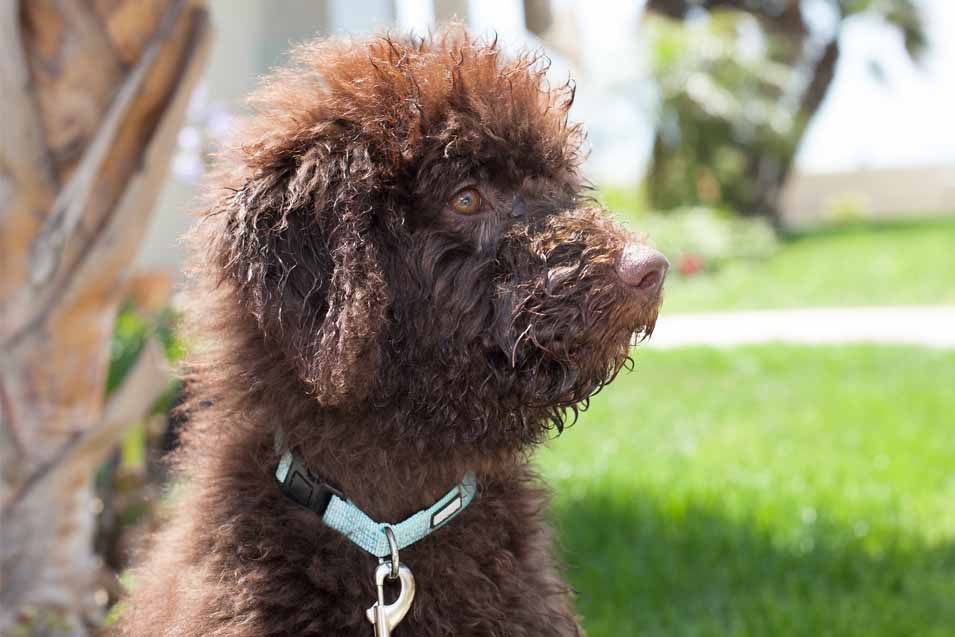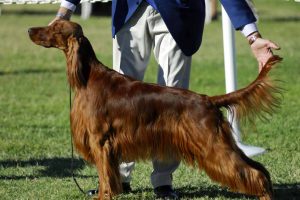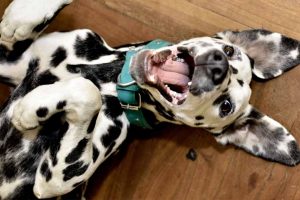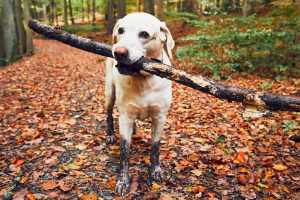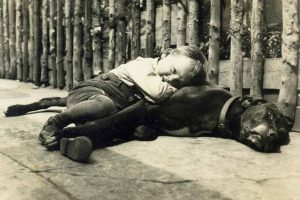Doodles are wildly popular today but how much do you know about them? Are they breeds? Hybrid dogs? How do they compare to purebred dogs or mutts? What’s good about them and what’s bad about them? Is a “doodle” the right dog for you? Keep reading and we’ll answer these questions and more!
What are doodles?
Doodles are crossbreeds of two purebred parent dogs. In most cases, one of the parent dogs is a Poodle – hence the term “doodle” in the name. Poodles are used as one of the parents because they have a single-layer coat and don’t shed. They are also super smart, easy to train, and have a good temperament. Breeders hope that these traits will be passed along to the puppies. The other parent can vary, depending on the kind of “doodle” you are seeking.
The original doodle was the Labradoodle, developed in Australia from a cross of a Standard Poodle and a Labrador Retriever in the 1970s. Labradoodles have remained one of the most popular kinds of doodles over the years. Other popular doodles include Goldendoodles (Poodle x Golden Retriever); Bernedoodle (Poodle and the Bernese Mountain Dog); the Aussiedoodle (Poodle x Australian Shepherd); the Schnoodle (Miniature Poodle x Miniature Schnauzer); and the Whoodle (Standard Poodle x Soft-Coated Wheaten Terrier). These are only a few popular doodles. There are many others.
Doodles can also have more complex parentage. Some breeders are breeding doodles from multiple generations of crossbred dogs. For example, a Goldendoodle might have two Goldendoodle parents; or one Goldendoodle parent and one Poodle parent, to emphasize the non-shedding trait.
Are doodles breeds?
Technically, doodles are not breeds like purebred dogs. Even if you breed several generations of doodles, such as a Labradoodle, the dogs do not breed “true.” If you breed several generations of, say, Irish Setters, they will always produce dogs that look like Irish Setters. However, if you breed several generations of a Labradoodle or a Goldendoodle they produce various kinds of puppies. Some of them will be non-shedding; some will shed; some will have curly coats; some can resemble their retriever ancestors; and some can even have fur that is mixed on their bodies. It’s possible that sometime in the future breeders might produce doodles that breed true and become a breed, but that’s not the case yet.
There are Labradoodle breeders in Australia http://www.laa.org.au/ working to achieve breed status for Australian Labradoodles but these dogs are separate from most of the Labradoodles found in North America. If you are interested in one of these dogs you should contact the Australian Labradoodle Association.
Are doodles hybrids?
Doodles are often referred to as “hybrid dogs” but this is technically not correct. From a biological viewpoint, a hybrid refers to interbreeding between two species or subspecies, such as a horse and a donkey to produce a mule. The resulting offspring is usually sterile. This is not the situation with doodles. They are simply crossbred dogs and they produce puppies that are completely fertile.
Some people refer to doodles are “designer dogs” and this is more accurate than calling them hybrids.
Some people refer to doodles as “mutts,” but this is not usually accurate either, unless someone is simply tossing dogs together indiscriminately without any thought about what they are producing. Producing nice doodle puppies for families takes thought and dedication, the same as it does to produce any good, healthy puppies.
What about hybrid vigor?
There are pros and cons with crossbreeding dogs. A puppy’s health often depends on the health of the parents. Some health problems can be avoided by breeding away from a dog’s breed, which might be called “hybrid vigor.” However, if the parent breeds share the same health problems, a breeder might not be avoiding the problem just because they are crossbreeding. For example, a variety of eye problems and cardiac problems show up in both Labrador Retrievers and in Poodles. The breeds don’t share some other issues, but it’s very important that any dogs used for breeding have health tests done to make sure that they don’t have overlapping health issues that might produce problems in their puppies. This is true of ALL dogs, whether purebred or crossbred. Any dog can have potential health problems. Even breeding two total mutts together can lead to puppies with health problems.
Just because dogs are crossbred or from unrelated breeds doesn’t mean that their offspring will be free of health issues.
When you are looking for a doodle puppy, it’s important to talk to the breeder about what health testing the parent dogs have had.
What are the characteristics of a doodle?
Some characteristics will vary, depending on the parent dogs and the breeds involved, but most breeders try to produce puppies that have wavy or curly coat that is non-shedding or low-shedding. Not all doodles are non-shedding. Most litters will have puppies that have a variety of coats and some of them may shed. Shaggy, wiry, and woolly coats are even possible, depending on the breeds involved. This is something you should discuss with a breeder before buying a doodle puppy, especially if you are looking for a puppy that is non-shedding.
Doodles also come in different sizes, depending on the parents. Most breeders use Standard Poodles or Miniature Poodles as one of the parent dogs but the other parent can be big or small. Goldendoodles, with a Golden Retriever parent, can sometimes grow to be 90 pounds or more. Your puppy has a better chance of being a medium-sized adult if one of his parents is a Miniature Poodle but there are really no guarantees, especially if one of his parents is a larger dog.
Most doodles have parents that are very people-friendly. They can have a sporting, herding, or terrier parent and that will help determine some of their other instincts.
What is an F1B?
Doodle breeders have certain terminology for their breeding programs. Here are some of the common terms used.
- P Generation: the purebred dog parents (such as the Golden Retriever and the Poodle)
- F1 Generation: the first generation produced from breeding together the purebred parents. This would be 50 percent Golden Retriever and 50 percent Poodle for a Goldendoodle.
- F1B Generation: this generation is produced from an F1 parent and a purebred parent. For the Goldendoodle, this would be a Goldendoodle F1 and a Poodle. These dogs are also called second generation Goldendoodles. These dogs are 75 percent Poodle and 25 percent Golden Retriever.
Breeders can go on in this way with the FB, F2B, F3, and other generations. They can breed back and forth to the original breeds and the crossbred generations. After breeding this way for several generations a breeder can produce Goldendoodles (or other doodles) that are more predictable and consistent in size and appearance. As you can see, this kind of breeding program takes years to build. If you buy a doodle from this kind of breeder it’s easier to predict how large your puppy will be as an adult.
What kind of grooming do doodles need?
Your doodle’s grooming will depend on his coat type and texture. All dogs need to have some grooming. Dogs with curly coats look like they don’t shed but the dead hair actually sheds into their curls (instead of in your house). These coats need to be combed/brushed regularly so they don’t form mats. Dogs with wavy or straight coats need to be brushed regularly so they don’t shed on the floor.
If you like to keep your dog clipped, dogs with longer coats (more than one inch) can be professionally groomed about once a month. For dogs with shorter coats (less than one inch), see a groomer every 6-8 weeks. And don’t forget to brush your dog at home several times per week.
What should you ask a doodle breeder?
Ideally you will be able to meet the breeder in person and see the puppies before you buy one. That’s not always possible today because of distances. Some breeders are also reluctant to allow strangers in their homes now because of bad past experiences. Whatever the case, you should see pictures of the puppies and the breeder should make time to discuss them with you.
- You should talk to the breeder about her breeding program.
- Ask about the parent dogs, including their breeds, temperament, and health testing.
- Ask the breeder about the coats on the puppies. Are they non-shedding? Curly? Wavy?
- If you have a color preference, you should mention it.
- If you have a preference for male or female, you should discuss it.
- Ask the breeder about their contract and/or health guarantee.
- Discuss the price of the puppy; ask what kind of deposit is required.
- Talk to the breeder about the age when the puppies leave home.
- Discuss what kind of house training the puppies will have before they leave home.
- Ask the breeder if she is available to offer advice after the puppy is in your home.
- Tell the breeder if you have any plans to do things with your puppy such as taking obedience lessons.
- Let the breeder know if you have children and what your home is like.
The more you and the breeder get to know each other, the better for both of you and for the puppy. But do keep in mind that a breeder is busy taking care of puppies and dogs so don’t expect her to be on the phone or texting with you all the time. Many breeders also have a full-time job, in addition to caring for a litter of puppies, so life is busy!
If you find a breeder you like but they don’t have a litter at the moment, you can usually ask to be placed on a waiting list to get a puppy when they have a litter.
The bottom line
There are a vast array of doodles available today and many of them make great family dogs. Virtually all of them have a Poodle as a parent since Poodles are non-shedding, smart, and good with people. The other parent can make your doodle puppy a wildcard. Doodle puppies literally come in all shapes, sizes, and colors, depending on the cross of breeds used. Talk to the breeder about health testing and other important issues before you buy.

